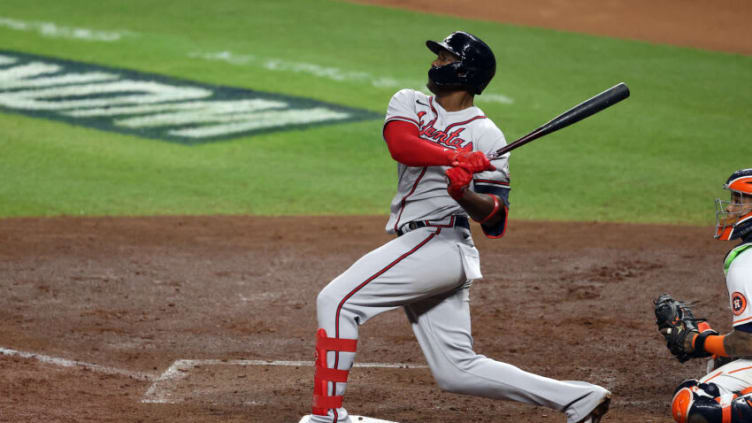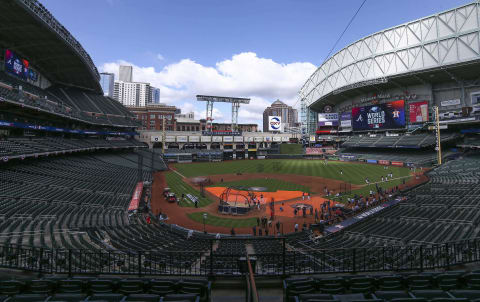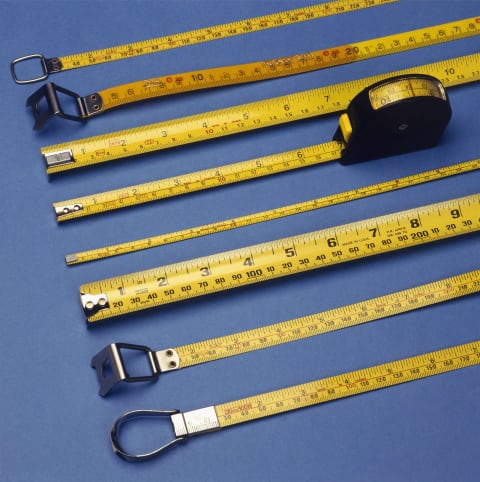Atlanta Braves: How long was Jorge Soler’s World Series homer?


It was a game-changer for the Atlanta Braves on their way to the World Title, but how far did that home run really travel?
It’s Game 6 of the 2021 World Series. Top of the 3rd inning. No score. The Atlanta Braves have a mild threat going against Houston starter Luis Garcia.
Ozzie Albies had led off the inning with a single that was sharply lined into right field between a pair of shifted infielders. He was the first base-runner of the game for the Braves.
Travis d’Arnaud and Dansby Swanson followed with outfield flyouts — the latter went 332 feet, but not quite squared up enough to do damage.
Eddie Rosario then drew a 2-out walk to bring up Jorge Soler.
Now Garcia had made Soler look almost foolish at the plate in the first inning with a big slider that induced a flailing swing on a 3-2 count. That was out #2 with no one on base at the time.
In this 3rd inning, though, Garcia had a quandary: behind Soler was Freddie Freeman… a right-on-left matchup that he certainly did not want to face, especially given that his best scenario would be a bases-loaded situation.
But the AB lingered on and Garcia had already shown Soler his best stuff in that first inning. It would be both gutsy and risky to throw that big slider again in this situation.
Three cutters and a fastball led to a 3-1 count. Danger. Two sliders were then thrown for strikes… one looking and the other fouled off.
With the count at 3-2 (again), he challenged Soler with a 96 mph fastball… lowish and near the middle of the plate. Another foul. Garcia is still one strike away from getting out of the inning unscathed.
Now what? Soler had either covered or spit on everything in his arsenal, but after the heater, Garcia and catcher Maldonado settled on a cutter… probably hoping that the change of pace (13 mph slower) would catch Soler off guard.
Not only did that not happen, but he threw it in virtually the same location as the previous pitch: thigh-high and on the inner half of the plate… but it stayed in that location only for a microsecond as the ball was turned around and carried with it all the air in the park… despite the roof being open.
3-0 Braves. It was a momentum shifter that the Astros never recovered from.
Statcast ridiculously reported the distance on this 109.6 mph blast at 446 feet… but then again, that was probably the limits of its vision since there’s usually a wall of glass just beyond the train tracks.
This ball left the stadium.

Where Did It Go? Did Anybody Care?
It was inevitable that someone would eventually find that baseball. It was, in fact, still in Houston, though there was speculation it might be anywhere between Woodland Heights (NW Houston) and Austin… or still orbiting the planet in a manner that might require satellites to adjust their own paths.
But there is someone who claims to have the ball, and the letter describing how he obtained it is interesting in its detail.
Normally, special souvenir game momentoes (balls, bats, etc.) are authenticated on the spot by a small army of team employees who are deployed around the ballpark exactly for this kind of reason… making sure that the relic is what it purports to be.
We learned some of this thanks to an interview our Kyle Walter conducted with the head authenticator of the Miami Marlins last year… a fascinating look at how this little-known job gets done.
In this case… Jorge Soler didn’t give any of the Astros’ authenticators a chance to execute their service since the ball was literally put out of their reach… and everyone else’s.
That brings us to Manuel Ramos IV.
Manuel and his brother Richard were trying to watch the game from a 6th-floor balcony in the apartments at 500 Crawford Street. Their view was quite a ways from the action, but at 60+ feet above the street, they did have an angle beyond left field thanks to the open roof.
In his letter describing the process of getting the baseball, Manuel notes seeing the flight of the ball leaving the stadium, striking “an awning outside” and then rolling to a stop on the sidewalk along Crawford Street.
Nobody went for it. Finally, after “approximately eight minutes” Manuel decided he ought to take action and ran down the stairs to snag his prize… a ball that he thinks should be worth… well, at least $36,603 since the current auction bid is at that level while not yet reaching his reserve price.
But I’m not interested in the price of that baseball today… I just want to know how far it traveled. We might just have enough info to figure that out.

Ask Mr. Google…
UPDATE: WE HAVE NEW EYEWITNESS INFO AVAILABLE. IF YOU’D LIKE, GO AHEAD AND SKIM THROUGH THIS PAGE FOR BACKGROUND INFO, BUT THE NEW INFO IS ON THE NEXT PAGE.
Google Street View is helpful here. Along that stretch of Crawford Street, there is exactly one awning that could possibly be involved: it covers the entrance to the apartment building Ramos was in at 500 Crawford Street.
It’s the other end of the ball’s flight that actually has more uncertainty about it. There are precious few photos available that clearly indicate where home plate is located within Minute Maid Park… photos with the roof opened, that is.
In fact, one of the photos available pre-dates the construction of the apartment building that we need as the ball’s landing spot.
Both Google Maps and Google Earth currently show the stadium with the roof closed, so it’s actually imperative to have an aerial view that shows where home plate resides.
There is one such pic showing the view toward left field that helps establish the location of the left field foul line.
For the right-field foul line, this view and the equally-ancient pic noted earlier are about as good as we can get. Not definitive, but pretty close for our purposes as we can extrapolate the lines to architectural features of the stadium walls.
Thus we can at least make a decent approximation of the distance from that awning back to home plate… with one slight caveat.
As it happens, there is not a direct line to the awning in question without going through the Union Station building… and video replays show clearly (start at roughly the 3:37 mark) that the ball did not have the height to clear that 5-to-6 story structure.
So either (a) the ball bounced around a bit before caroming over to the awning, or (b) there was another, newer awning installed that we don’t yet have a Google Street View picture of — though frankly, it’s not at all obvious where another awning could be installed. Let’s go with “(a)”.
I’ve got a theory about how the ball got there, too… just stand by for a minute, for it’s time for the numbers.

Which number do you want?
Using Google Earth, we can draw a line from that 500 Crawford St. awning to our estimated home plate location.
Measuring somewhat conservatively, that works out to something close to 584 feet.
Given that this could not have been the direct path, I also measured a couple of additional trajectories that might have been in play without caroms being involved. Those worked out to distances between 590 and 594 feet to reach the far side of Crawford St. on a direct line.
Then there’s the question about how far the ball flew in the air. That’s much more difficult to discern, but check out this Google Street View shot of the Left Field entrance to the stadium.
Note the sloped roof… perfect to redirect the ball toward the 500 Crawford St. Apartments awning. My belief is that the ball struck that roof and bounced across the street toward the awning from there.
That measurement? Somewhere between 470 and 490 feet on the fly… and it likely would have made 500 feet had that roof not been in the way (which itself is above the ground by approximately 7-to-16 feet).
There’s nothing obvious on the photos of the ball itself to suggest impact with something green like that roof is painted… so that part remains inconclusive.
NEW Information
This comes directly from Rick Ramos, one of the eyewitnesses that night who has kindly enlightened us with the details needed.
Here is a picture of the awning from the World Series. Hit the center top portion of the awning. @carpengui pic.twitter.com/37gXxdEosf
— Rick Ramos (@RicRam1976) January 27, 2022
In short: the awning referred to in Manuel’s letter is NOT the one at the entrance to the apartments. It was actually the curved roof over the stadium entrance. We thank Mr. Ramos for providing that clarification!
So we guessed correctly that the ball hit that roof — “awning” — but instead we’re looking at more of a direct line to bounce it across the street to the point it was picked up… no left turn from that Minute Maid Park left-field entry awning.
That changes our estimated distance… but not by a lot. The updates to those measurements are below.
The surveyor says….
Here’s the new conclusions we can draw from that:
- The ball almost certainly traveled something in excess of 470 feet in the air before hitting anything.
- Had the ball continued to ground level before striking any object, a 500 ft. result is a reasonable extrapolation, given it’s relatively flat trajectory when leaving the park (it began life with a 27-degree launch angle).
- Counting rolling and the bounce off the Astros awning, etc., a final distance of at least 590 feet now appears quite plausible.
While others may have clouted longer drives interrupted by stadium walls, this still should have ranked as one of the longest drives recorded in 2021… all the more remarkable given that Soler turned around a pitch thrown at “just” 83 miles per hour.
Statcast rankings for the year (regular season only):
- Miguel Sano: 495 feet
- Tommy Pham: 486
- Adam Duvall: 483
- Ryan McMahon: 478
- Fernando Tatis, Jr: 477
- Trevor Story: 475
These figures aside, Soler’s shot was clearly the longest one on the biggest stage in Atlanta Braves baseball history… and that goes back quite a ways.
All about Joey E. dark. Next
It also crushed the hopes and dreams of an entire stadium of Astros fans as the Atlanta Braves cruised from there. Game over. Season over.